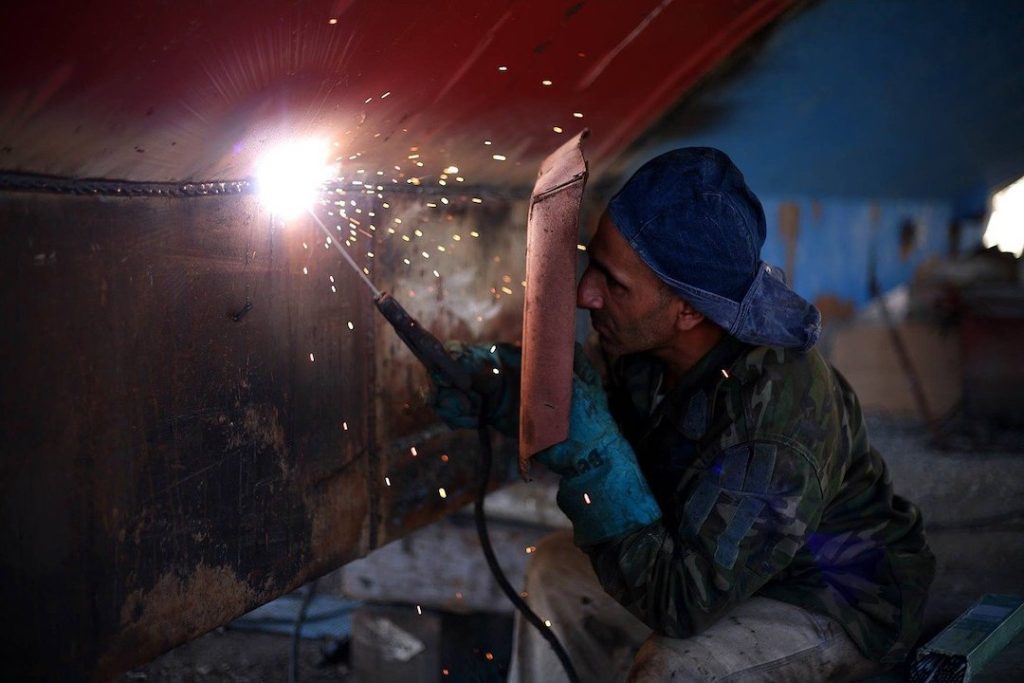As a crafts person, you know the importance of safety and how complex welding can be. It uses a combination of skills to successfully and safely execute a weld. While not as dangerous as other professions, there are still risks involved in welding – it’s recommended that you wear the necessary safety equipment when practicing the craft.
Welding is a dangerous job that requires you to wear the right safety equipment. If you’re not equipped with the necessary tools, staying safe while welding can be challenging. That’s why we want to make sure you know about these six tips on how to stay safe while welding.
Always use your gloves
Handling extremely hot metal pieces can easily lead to burns. Make sure you’re always wearing welding gloves while you’re working, as they’ll provide a layer of protection between your skin and the metal. Depending on the technique, use, tools, and experience, the process and levels of caution can vary. As you probably know, TIG process is different to MIG, so different levels of caution are advisable. Some welders don’t like to wear gloves because they make it hard to hold the welding torch. If you’re having trouble gripping the welding torch with gloves on, try loosening your gloves a bit or tucking them inside your sleeves.
Before using your welding equipment, make sure you’re familiar with its functions. Make sure you know how to adjust the intensity and heat levels on your MIG welder, TIG welder, plasma cutter, and any other equipment you use. Also keep in mind your surroundings and level of precision, as different pieces of equipment have different operating ranges. Don’t take any unnecessary risks when using your welding machine or equipment.
Be aware of your surroundings
Like other materials from our work surroundings or homes, welding can cause bright light and intense heat. Make sure you’re aware of your surroundings and the people around you and avoid welding in an area with flammable materials. Depending on where your workstation is set up, you may need to take additional precautions to avoid fires. Materials that are flammable like wood and paper can catch fire quickly and cause your environment to go up in flames.
In addition to gloves, you should also wear a welding helmet, apron, and boots. The welding helmet will protect your eyes from the bright light and sparks that come off the metal. The apron will protect your clothes from getting dirty or stained, and the boots will protect your feet from getting burned.
Sparks can fly off the metal during welding and can easily start a fire. Make sure you’re aware of where the sparks are landing and take steps to avoid fires. Keep a fire extinguisher nearby in case of an emergency. Welding can also produce harmful fumes. Make sure you’re wearing a respirator to protect your lungs from the fumes.
Wear the right clothing
Welding can also produce sparks, so it’s important to wear clothes that will protect you from getting burned. Try wearing a long sleeve shirt and jeans or pants that cover your ankles. Make sure the clothes you’re wearing aren’t too loose, as they could catch fire and get in the way of protection tools like welding gloves and helmets. If you’re going to be welding for an extended period, consider wearing earplugs, so your ears don’t get burned or get damaged from the sparks.
Welding is a dangerous job that requires you to wear the right safety equipment. If you’re not equipped with the necessary tools, staying safe while welding can be challenging. Make sure all clothing touching skin is made of cotton, wool, or another natural fiber rather than synthetic materials such as nylon because they can melt onto the skin and fuse it shut if they catch fire during welding.
Avoid wearing jewelry and losing clothing
Loose clothing can catch fire, and jewelry can become red-hot and burn the skin. Wearing loose clothing (even though it should be too tight too) can leave your skin too exposed. If you do wear loose clothing, try wearing a tight undershirt that covers your skin. Wear clothes that are comfortable but protective, like jeans, belts, and long sleeve shirts.
Make sure the jewelry you’re wearing isn’t made of gold or silver because they can become scorching hot and burn your skin if they come in contact with the piece of metal you’re welding on. Instead, wear some form of protective gear to protect your hands from heat and sparks.
Make sure to have the right amount of clearance
Before welding on any piece of metal, make sure you have enough room to safely use it. Welding can be dangerous if you’re using the wrong equipment or technique for the job. Make sure all you’re doing is welding and not creating an unsafe work environment. For example, if you’re creating excessive sparks or heat that can harm people or other objects in the area, consider using a different piece of equipment to weld on your metal.
The advised amount of space between your welding station and any flammable objects is about three times the width of the welding torch. You don’t want to be in a situation where you’re so close to something flammable that if you were to have an accident, the flames would quickly spread to that object.
Use a fire extinguisher
Keep a fire extinguisher handy in case of emergencies like fires that break out around you while you’re welding. Make sure you know how to operate it, as using an extinguisher incorrectly could spread the fire. Keep your work area clean and free of any combustible materials to avoid fires.
If you do ever have a fire, make sure to get out of the way as quickly as possible and call for help. If it’s too late and the fire is already burning your skin, use cool water on it until help can arrive. Stay calm and remember that applying direct pressure to a burn will only damage the skin further and should be avoided.

Welding is a dangerous but necessary job. Make sure to follow these tips to stay safe while you’re welding, and remember that safety should always be your number one concern while working. If you have any questions about welding safety, don’t hesitate to reach out to your local welding professionals. Make sure you wear the right safety equipment, including a welding helmet, apron, boots, and gloves. Do your research and make sure you know which safety precautions to take before welding, as it can be challenging if you’re not equipped with the necessary tools to stay safe.










